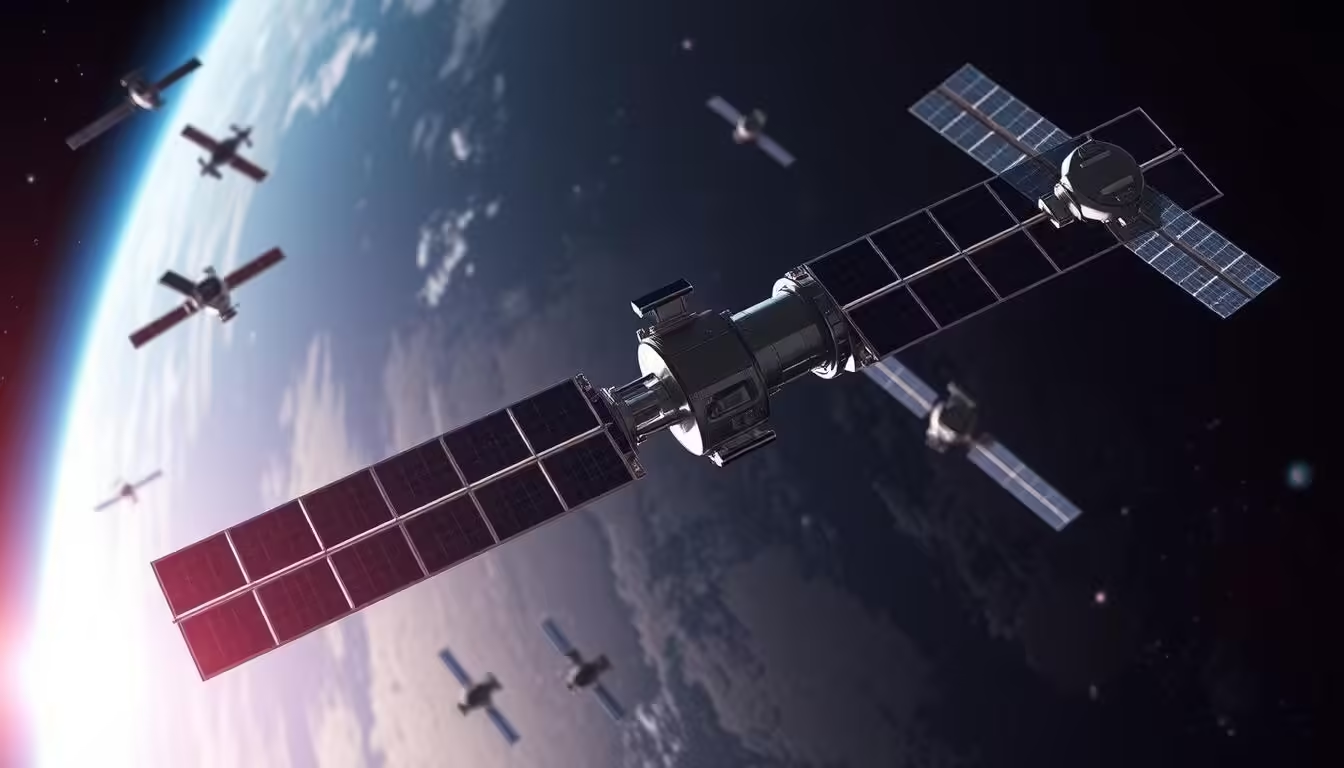Satellites have become an integral part of our daily lives, playing a crucial role in navigating our way through the world and monitoring the health of our planet.

From providing accurate GPS navigation to tracking severe weather conditions, these satellites are instrumental in enhancing our understanding of the world and its complexities.
The significance of satellites cannot be overstated, as they contribute substantially to our ability to predict weather patterns, manage natural resources, and respond to natural disasters.
Key Takeaways
- Over 2,000 active satellites are currently orbiting Earth.
- Satellites play a vital role in GPS navigation and environmental monitoring.
- They help track severe weather conditions like wildfires and hurricanes.
- Satellite technology enhances our understanding of the world and its complexities.
- The data from satellites is crucial for predicting weather patterns and managing natural resources.
The Evolution of Satellite Technology
Since the launch of Sputnik, the first artificial satellite, the technology behind satellites has undergone significant transformations. Sputnik’s launch in 1957 marked the beginning of the space age, sparking a chain of innovations that have led to the sophisticated satellite networks we rely on today.
From Sputnik to Modern Satellite Networks
The journey from Sputnik to modern satellite networks has been marked by several key milestones. One of the most significant was the launch of early communication satellites, which enabled transcontinental communication and paved the way for modern telecommunications.
Milestone Launches That Changed History
- The launch of Telstar 1 in 1962, the first active communications satellite, revolutionized telecommunications.
- The deployment of the Global Positioning System (GPS) satellites began in the 1970s, providing global navigation capabilities.
- Modern satellite constellations like Starlink are transforming global internet connectivity.

Key Technological Breakthroughs in Satellite Development
One of the critical technological advancements in satellite development has been miniaturization. By reducing the size and weight of satellites, miniaturization has lowered launch costs and increased the accessibility of space technology.
How Miniaturization Revolutionized Space Technology
Miniaturization has enabled the development of CubeSats, small satellites that can be built and launched at a fraction of the cost of traditional satellites. This has democratized access to space, allowing universities, startups, and even hobbyists to launch their own satellites.
“The miniaturization of satellites has opened up new possibilities for space research and technology development, making it possible for a wider range of organizations to participate in space activities.”
| Technological Advancement | Impact on Satellite Technology |
|---|---|
| Miniaturization | Reduced launch costs, increased accessibility |
| Advanced Materials | Improved durability and performance |
| Digital Signal Processing | Enhanced communication capabilities |
Understanding Earth’s Orbital Highways: Where Satellites Live
Understanding the different orbits where satellites reside is crucial for appreciating their roles. Earth’s orbit is not just a random collection of satellites; it’s a complex system with various layers, each with its own set of operational parameters and applications.

Low Earth Orbit (LEO) Satellites and Their Applications
Low Earth Orbit satellites operate at altitudes between 160 to 2,000 kilometers. These satellites are used for a variety of purposes, including Earth observation, scientific research, and telecommunications. LEO satellites are particularly useful for high-resolution imaging of the Earth’s surface due to their proximity to the planet.
Medium Earth Orbit (MEO) and Geostationary Satellites
Medium Earth Orbit satellites orbit at altitudes between 2,000 and 36,000 kilometers. This category includes navigation satellites like GPS, which rely on a network of satellites in MEO to provide location information worldwide. Geostationary satellites, a special case of MEO, orbit at approximately 36,000 kilometers and remain stationary relative to a point on Earth’s surface, making them ideal for weather forecasting and telecommunications.
The Challenges of Orbital Placement and Traffic Management
As the number of satellites in Earth’s orbit increases, so does the challenge of managing orbital placement and traffic. With more satellites, the risk of collisions and the accumulation of space debris grows. Effective management of Earth’s orbital highways is essential to ensure the continued safe operation of satellites and to mitigate the risks associated with orbital debris.
Navigation and Communication: How GPS Satellites Transform Daily Life
The impact of GPS satellites on modern life is multifaceted, influencing everything from navigation to communication. GPS technology has become an integral part of our daily activities, from driving directions to precision timing in financial transactions.

The Global Positioning System Architecture
The Global Positioning System (GPS) relies on a network of satellites orbiting the Earth. This constellation ensures that at least four satellites are visible from any point on the planet, providing the necessary data for precise location and time information.
The 24+ Satellites That Help You Never Get Lost
The GPS system consists of at least 24 operational satellites. These satellites are distributed across multiple orbits, ensuring global coverage and the ability to provide location information anywhere on Earth.
| Satellite System | Number of Satellites | Primary Use |
|---|---|---|
| GPS | 24+ | Navigation, Timing |
| GLONASS | 24+ | Navigation |
| Galileo | 30+ | Navigation, Timing |
Beyond Navigation: Timing Applications of GPS Satellites
GPS satellites are not just crucial for navigation; they also provide precise timing signals. These signals are used in various industries, including finance, telecommunications, and energy, where synchronized timing is essential.
Next-Generation Navigation Satellite Systems
As technology advances, next-generation navigation satellite systems are being developed to offer even greater precision and reliability. These systems will enhance the sustainability of GPS technology, ensuring its continued relevance in a rapidly changing world.
Earth Observation Technology: Our Planet Under Constant Watch
Our planet is now under surveillance like never before, thanks to the latest advancements in Earth observation technology. Satellites equipped with sophisticated sensors and cameras are providing unprecedented insights into Earth’s health, enabling scientists, policymakers, and the public to make informed decisions about our environment.
Remote Sensing Technologies and Applications
Remote sensing technologies have become a cornerstone of Earth observation. These technologies allow satellites to collect data on various environmental parameters, such as land cover, ocean color, and atmospheric composition. The applications are vast, ranging from monitoring crop health and detecting natural disasters to tracking changes in ice cover and sea level rise.

Tracking Climate Change Indicators from Space
Satellites play a crucial role in monitoring climate change indicators. They provide data on temperature changes, ice sheet extent, and sea level rise, among other metrics. This information is vital for understanding the pace and impacts of climate change, as well as for developing strategies to mitigate its effects.
“Satellite data have become indispensable for climate change research, providing a global perspective on environmental changes.”
Case Studies: Major Environmental Discoveries via Satellite
Satellites have facilitated numerous groundbreaking environmental discoveries. One notable example is the monitoring of Antarctic ice loss.
How Satellites Revealed Antarctic Ice Loss
Satellite observations have been instrumental in quantifying ice loss from Antarctica. By measuring changes in ice sheet extent and thickness, scientists have gained insights into the dynamics of ice sheet collapse and its contribution to sea level rise.
| Year | Ice Loss (Gt/yr) | Sea Level Rise Contribution (mm/yr) |
|---|---|---|
| 2000 | 100 | 0.2 |
| 2010 | 150 | 0.3 |
| 2020 | 200 | 0.4 |
The data clearly indicate an accelerating trend in ice loss and its contribution to sea level rise, underscoring the importance of continued satellite monitoring.
Disaster Management: Tracking Wildfires and Hurricanes in Real Time
Satellite technology has revolutionized disaster management, offering real-time insights into wildfires and hurricanes. This capability is crucial for saving lives and reducing the impact of these natural disasters.
Early Warning Systems That Save Lives
One of the most significant contributions of satellites to disaster management is the development of early warning systems. These systems can detect the early signs of wildfires and hurricanes, providing critical minutes or even hours for evacuation and preparation.
For instance, satellites equipped with thermal imaging can identify the initial stages of a wildfire, while those with advanced radar can monitor the formation and trajectory of hurricanes.
Wildfire Detection and Monitoring Capabilities
Satellites play a vital role in detecting and monitoring wildfires. They can identify fires in remote areas, track their spread, and provide data on fire intensity.
From Smoke Detection to Fire Progression Mapping
Advanced satellite sensors can detect smoke and heat signatures, allowing for early detection of wildfires. Furthermore, they can map the progression of fires, providing critical information for firefighting efforts and resource allocation.
Hurricane Tracking and Prediction Improvements
Satellites are also essential for tracking hurricanes, predicting their paths, and estimating their intensity. This information is vital for issuing timely warnings and evacuating people from affected areas.

By leveraging satellite data, meteorologists can improve the accuracy of hurricane forecasts, saving lives and reducing economic losses.
Satellite Technology Supporting Sustainable Development Goals
Satellite technology plays a crucial role in achieving the United Nations’ Sustainable Development Goals (SDGs). By providing critical data and connectivity, satellites are helping to address some of the world’s most pressing challenges.
Boosting Agriculture and Food Security from Space
Satellite imagery and data are being used to improve crop yields, monitor soil health, and detect early signs of disease or pests. This information enables farmers to make data-driven decisions, reducing the environmental impact of farming while increasing productivity.
Water Resource Management and Drought Prediction
Satellites are crucial in monitoring water resources, detecting changes in water bodies, and predicting droughts. By analyzing satellite data, authorities can better manage water supplies, plan for droughts, and implement early warning systems.
| Application | Benefit |
|---|---|
| Crop Monitoring | Improved Yields |
| Water Resource Management | Better Drought Prediction |
Bridging the Digital Divide with Satellite Internet
Satellite internet is connecting remote and underserved communities to the global network, providing access to information, education, and economic opportunities.
Connecting Remote Communities to the Global Network
By delivering high-speed internet to remote areas, satellite technology is helping to bridge the digital divide, fostering economic growth, and improving the quality of life for millions of people worldwide.
The Growing Challenge of Space Debris Around Earth
The accumulation of space debris in Earth’s orbit poses a growing challenge to the sustainability of space exploration and development. As the number of satellites and other objects in orbit increases, so does the risk of collisions that can generate even more debris.

Current State of Orbital Debris: A Space Junkyard
The current state of orbital debris is alarming, with thousands of defunct satellites and fragments cluttering Earth’s orbital highways. This debris can travel at speeds of up to 17,500 mph, making even small pieces potentially catastrophic.
Collision Risks and Mitigation Strategies
Collision risks are a significant concern, with the potential to cause significant damage to operational spacecraft. Mitigation strategies include designing satellites to burn up completely upon re-entry, maneuvering to avoid collisions, and implementing guidelines for responsible space operations.
| Mitigation Strategy | Description | Effectiveness |
|---|---|---|
| Design for Demise | Satellites designed to burn up upon re-entry | High |
| Maneuvering | Avoiding collisions through orbital adjustments | Medium |
| Guidelines for Space Operations | Industry best practices for responsible operations | High |
International Efforts for Space Sustainability
International cooperation is crucial for addressing the issue of space debris. Efforts include developing guidelines and regulations for sustainable space operations, sharing data on space debris, and collaborating on research and development of debris removal technologies.
By working together, the global space community can mitigate the risks associated with space debris and ensure the long-term sustainability of space activities.
The Future of Earth-Orbiting Satellite Technology
As we look to the future, Earth-orbiting satellite technology is poised to undergo significant transformations. The increasing demand for satellite-based services, coupled with advancements in technology, is driving innovation in this field.
The CubeSat Revolution: Democratizing Space Access
The CubeSat revolution is making space more accessible to organizations and countries that previously couldn’t afford it. These miniaturized satellites are not only cost-effective but also offer a quick turnaround time for deployment.
CubeSats are being used for a variety of applications, including Earth observation, technology demonstration, and scientific research. Their compact size and standardized design have opened up new opportunities for universities, startups, and small companies to participate in space exploration.
Mega-Constellations and Global Internet Coverage Plans
Mega-constellations are another significant development in the future of satellite technology. Companies like SpaceX and Amazon are launching large constellations of satellites to provide global internet coverage.
These mega-constellations aim to bridge the digital divide by offering high-speed internet access to remote and underserved areas. However, they also raise concerns about space debris and the need for effective regulation.
Emerging Applications and Green Space Technologies
The future of satellite technology is not just about communication; it’s also about emerging applications such as Earth observation, climate monitoring, and navigation.
Solar-Powered and Eco-Friendly Satellite Designs
As the industry moves towards more sustainable practices, green space technologies are gaining traction. Solar-powered satellites and eco-friendly designs are being explored to reduce the environmental impact of space missions.
Conclusion: Our Satellite-Enabled World and What Comes Next
As we navigate our daily lives, it’s easy to take for granted the vast network of satellites orbiting Earth. These technological marvels have become integral to our global infrastructure, supporting everything from GPS navigation to real-time disaster tracking. The satellite-enabled world we live in today is a testament to human ingenuity and our relentless pursuit of innovation.
Looking to the future, the role of satellites in promoting Sustainability and Green Tech will only continue to grow. With emerging applications in Earth observation, climate monitoring, and environmental protection, satellites will remain crucial in our efforts to protect the planet. As Technology advances, we can expect to see more efficient and sustainable satellite systems, further enhancing our ability to monitor and manage Earth’s resources.
The future of satellite technology holds much promise, from the democratization of space access through initiatives like the CubeSat revolution to the development of mega-constellations that aim to provide global internet coverage. As we move forward, it’s clear that satellites will play an increasingly vital role in shaping our world, driving progress in Sustainability, and fostering a more connected and environmentally conscious global community.



